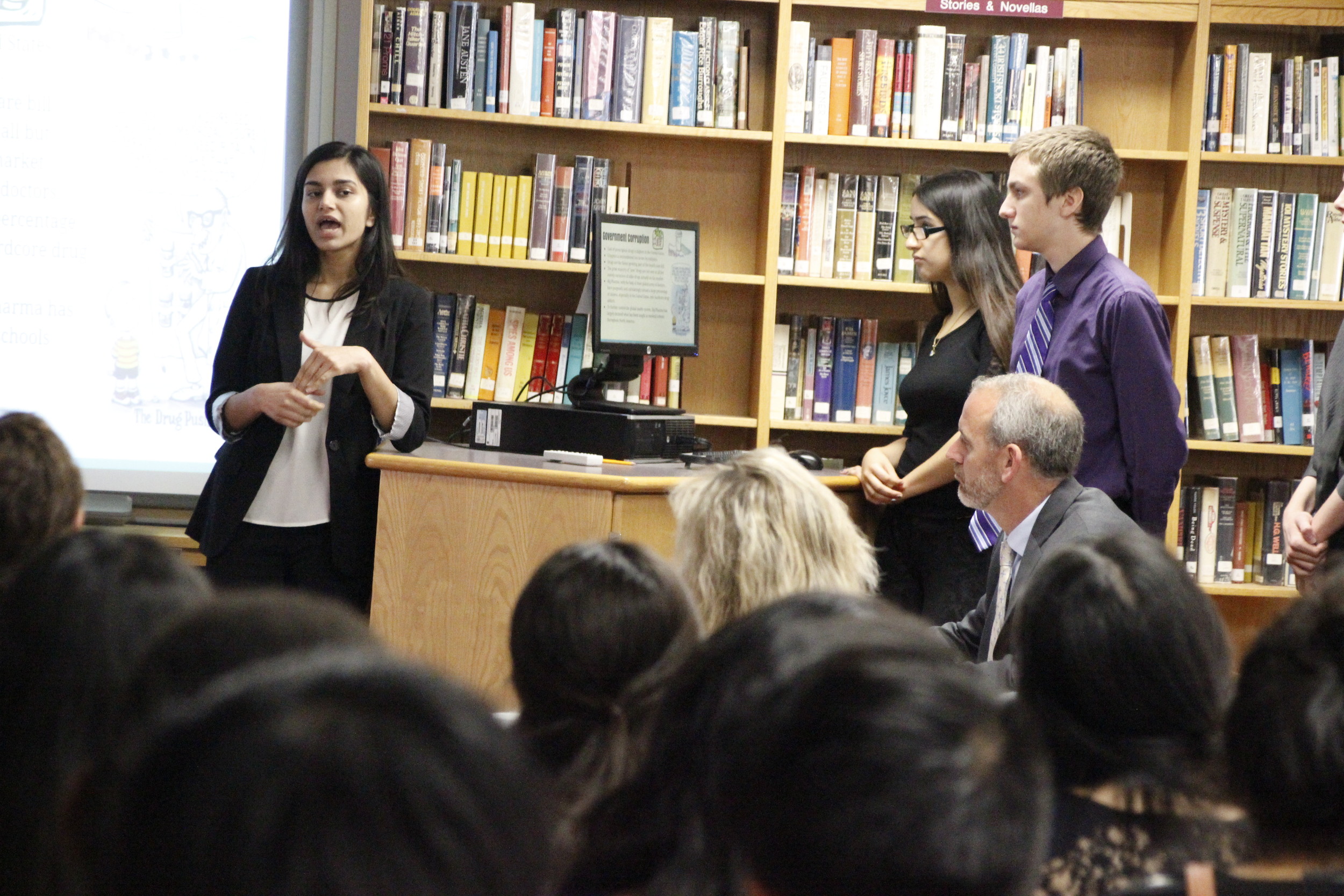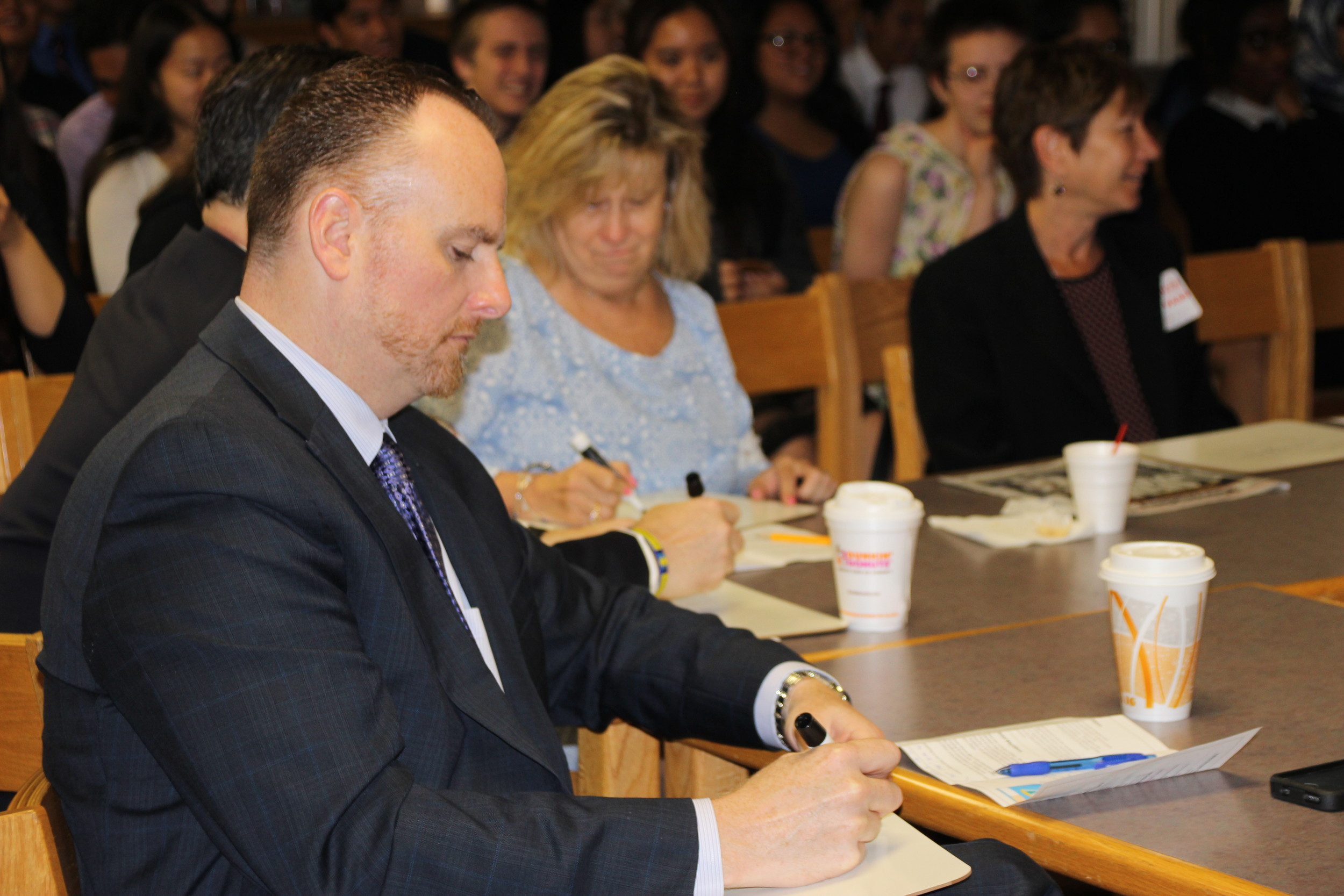Students talk prescription pills, Common Core and gender equality at South High School

South High School held its annual Project Citizen hearing on June 9, in which students presented detailed public policy action plans for national and global issues based on their extensive research.
“This is all student-driven,” said Peter Mastrota, a history teacher at South. “Where the course for the year is driven by the teachers, at the end we hand it over to them and say, ‘Now the ball is in your court.’”
This year’s topics included the prescription painkiller epidemic, the Common Core curriculum and gender inequality. Students presented their solutions to a panel of school administrators and representatives for Senator Todd Kaminksy and Assemblywoman Michaelle Solages. Mastrota said the purpose was to directly connect the students to the political process.
Discussing prescription painkillers, the group focused on the perceptions of different kinds of drug use.
“Society makes excuses for the use of prescription drugs over street drugs,” said student Nick Tarrant. “Even though they can have the same effects, they excuse prescription drugs.”
Tarrant and his group members advocated for more accurate advertising that doesn’t try to obscure the negative effects of prescription drugs. Through their research, they stated that the amount of prescriptions being issued in the United States was disproportionate to the population, and that medications are often prescribed to mitigate the side effects of other prescriptions, which the students said perpetuated the cycle of addition.
Student Rimsha Qureshi said she believed that the disproportionate amount of prescriptions was because the pharmaceutical industry is able to make enormous profits from prescription drugs.
“There’s huge [pharmaceutical] companies, such as Pfizer, Johnson & Johnson and Merck, who are grossing around $711 billion in 10 years,” she said. “That’s not a small amount of money, and to think that just 10 companies are making this much in 10 years — where is all this money coming from?” Qureshi said. She added that people addicted to medications aren’t widely considered addicts because the stigma that accompanies illicit substances doesn’t apply to prescribed substances.
The group’s solution to the issue: Place stricter regulations on doctors and the issuance of medication.
“The first step would be integrating stricter regulations on the drug industry,” said Eric Nelson. “Particularly, we would advocate for a tightening of the control of the prescription process itself … For a minor injury, you wouldn’t be given Vicodin.” Additionally, the group felt that natural remedies and holistic practices, which can be very effective, need to be explored.
Also on the themes of corporate profit and public interest, students who examined the Common Core curriculum and its implementation in New York felt that education needs to be more localized, the aim being to remove corporate interests from the process altogether.
“Companies like Pearson that are making money off of this, they’re telling us what software to use, what textbooks to use, what tests to take,” said Maya Voytelmgum. “They’re the ones benefitting by making money. They don’t know how students in Valley Stream learn. We learn a completely different way than students in Texas or California learn, so why should we all be taught the same way? Take the same tests? Read the same books?”
The group gave dry-erase boards to the panelists and asked them to complete a first-grade Common Core math equation. Each of the adult panelists answered incorrectly. The students used this an example of the undue stress and frustration the curriculum causes, and suggested a more individualized framework for education by abolishing the U.S. Department of Education.
“If we removed the Department of Education, the states would have more power over the schools and the districts and it would make it more localized,” said Randy Kipnis.
Tackling the global issue of gender inequality, students provided context for the way women are treated in different regions of the world by examining dowry deaths in India, a country that has a longstanding tradition of patriarchy.
“Traditionally, the bride’s family will pay for the wedding,” said Wayne Chen. “Now, if the bride’s family cannot pay for the wedding, or the groom does not find the present sufficient to his standings, he is allowed to kill the wife and find another one.”
Chen and his group members covered a wide range of inequality issues, ranging from female athletes’ salaries to breast-feeding in public. Natalie Peralta noted that after the U.S. women’s soccer team won the 2015 FIFA World Cup, the team was paid $2 million. When the U.S. men’s soccer team lost in the first round, they were paid four times that.
Chen noted that he has seen a shift in the way his peers celebrate men’s and women’s teams. “Now boys are [buying] women’s soccer jerseys,” Chen said. “That’s huge.”
The group’s action plan called for social media campaigns and media platforms to continue to recognize sexism in mainstream culture all over the world, and to educate people about the issues at an earlier age.
All six students who covered gender inequality continued discussing the issues among themselves after they’d presented. Victoria Konieczny said that was evidence of their passion about the subjects they chose to discuss.
“Everything just came together because we felt powerfully about what we were talking about,” she said.

 50.0°,
Fair
50.0°,
Fair 







